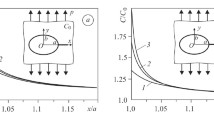Abstract
We outline basic regularities of the processes running in “deformed-metal-hydrogen” systems characterized by the existence of close correlations between the motion of hydrogen in the metal and the accumulation of defects. We select the specific features of the methodological and methodical aspects of evaluation of the influence of hydrogen on the physicomechanical properties of materials explained by the unique properties of hydrogen, namely, its extremely high diffusive mobility in solids and active localization in structural defects. Within the framework of the continuum mechanics of damage, we pose and solve the problem of diffusive penetration of hydrogen through a metal under loads. Unlike the well-known McNabb model, the proposed mathematical description of the action of defects as hydrogen traps takes into account the effect of mechanical loading of the material. In the statement of the problem, we reflect the influence of defects on the behavior of the surface concentration of hydrogen in the process of saturation. The numerical results are compared with the experimental data obtained for the process of cathodic hydrogenation of deformed steel specimens in acid and neutral media. The accumulated analytic results satisfactorily describe the complex character of influence of the level of stresses on the hydrogen permeability of steels.
Similar content being viewed by others
References
H. V. Karpenko and R. I. Kryp'yakevych, Influence of Hydrogen on the Properties of Steel [in Russian], Metallurgizdat, Moscow (1962).
M. M. Shved, Variations of the Operating Characteristics of Iron and Steel Under the Influence of Hydrogen [in Russian], Naukova Dumka, Kiev (1985).
V. I. Tkachev, V. I. Kholodnyi, and I. N. Levina, Serviceability of Steels and Alloys in Hydrogen [in Russian], Vertikal', Lvov (1999).
V. I. Tkachov, “Problems of hydrogen degradation of metals,” Mater. Sci., 36, No. 4, 481–489 (2000).
L. S. Moroz and V. V. Chechulin, Hydrogen Brittleness of Metals [in Russian], Metallurgiya, Moscow (1978).
B. A. Kolachev, Hydrogen Brittleness of Metals [in Russian], Metallurgiya, Moscow (1985).
Yu. I. Archakov, Hydrogen Resistance of Steels [in Russian], Metallurgiya, Moscow (1978).
Hydrogen Degradation of Ferrous Alloys, Noyes Publ., Park Ridges (1985).
Hydrogen Effects on Behavior of Materials, Proc. of the Fourth Internat. Conf. (Moran, 1989), TNS (1990).
C. D. Beachem, “A new model for hydrogen-assisted cracking-hydrogen embrittlement,” Met. Trans., 3, No. 2, 437–451 (1972).
A. K. Litvin and V. I. Tkachev, “Phenomenon of facilitation of deformation and fracture of metals in the presence of hydrogen,” Fiz.-Khim. Mekh. Mater., 12, No. 2, 27–34 (1976).
A. W. Thompson and I. M. Bernstein, “The role of plastic fracture processes in hydrogen embrittlement,” in: Adv. Strength Fract. of Materials, Fourth Conf. on Fracture, Vol. 2A, Pergamon Press, New York (1978), pp. 249–254.
O. A. Ohyewuenyii, “Plastic instability and hydrogen in iron-based alloys,” in: Hydrogen Degradation of Ferrous Alloys, Noyes Publ., Park Ridges (1985), pp. 414–452.
H. M. Nykygorchyn and O. V. Student, “Influence of hydrogen on the formation of the fatigue thresholds of structural steels,” Mater. Sci., 37, No. 2, 252–263 (2001).
J. Toribio, “Evaluation and modeling of hydrogen-induced fracture in structural steels,” Mater. Sci., 32, No. 3, 368–382 (1996).
A. V. Fishgoit, T. N. Zueva, N. T. Bychkov, and L. F. Kurnosova, “Kinetics of electrolytic hydrogenation of Ni alloys under the influence of plastic deformation,” Fiz.-Khim. Mekh. Mater., 24, No. 3, 42–47 (1988).
L. M. Kachanov, Foundations of Fracture Mechanics [in Russian], Nauka, Moscow (1974).
V. P. Golub, “Nonlinear continuum mechanics of damage and its application to the problems of creep and fatigue,” Prikl. Mekh., 36, No. 3, 31–66 (2000).
A. McNabb and P. K. Foster, “On the rate of loss of hydrogen from cylinders of iron and steel,” Trans. Met. Soc. AIME, 227, No. 3, 618–627 (1963); 233, No. 5, 1022–1031 (1965).
M. A. Iino, “More generalized analysis of hydrogen trapping,” Acta Met., 30, No. 2, 367–375 (1982).
M. A. Iino, “Analysis of irreversible hydrogen trapping,” Acta Met., 30, No. 2, 377–383 (1982).
V. B. Kleshnya and N. G. Krapivnyi, “Investigation of the kinetics of interaction of hydrogen with defects in the structure of metals,” Sov. Mater. Sci, 28, No. 5, 410–413 (1992).
Ya. S. Matychak, I. P. Kuritnyk, and O. V. Pavlyna, “Specific features of mass exchange between multicomponent bodies of different nature under nonstationary conditions,” Mater. Sci., 37, No. 3, 480–490 (2001).
V. S. Pavlyna, “Mathematical modeling of interdependent physicochemical processes and degradation of viscoelastic materials under loading,” Mater. Sci., 35, No. 2, 151–156 (1999).
A. K. Litvin and V. G. Starchak, “On the problem of distribution of hydrogen in the subsurface layer of steel under the conditions of electric saturation,” Fiz.-Khim. Mekh. Mater., 1, No. 3, 293–298 (1965).
V. I. Tkachev, R. I. Kripyakevich, and A. K. Litvin, “Influence of stresses on the diffusion of electrochemically released hydrogen through steel,” Fiz.-Khim. Mekh. Mater., 2, No. 3, 321–325 (1966).
Author information
Authors and Affiliations
Additional information
__________
Translated from Fizyko-Khimichna Mekhanika Materialiv, Vol. 43, No. 5, pp. 5–13, September–October, 2007.
Rights and permissions
About this article
Cite this article
Pavlyna, V.S., Pavlyna, O.V. Hydrogen permeability in metals under the conditions of accumulation of defects. Mater Sci 43, 597–607 (2007). https://doi.org/10.1007/s11003-008-9003-4
Received:
Published:
Issue Date:
DOI: https://doi.org/10.1007/s11003-008-9003-4




